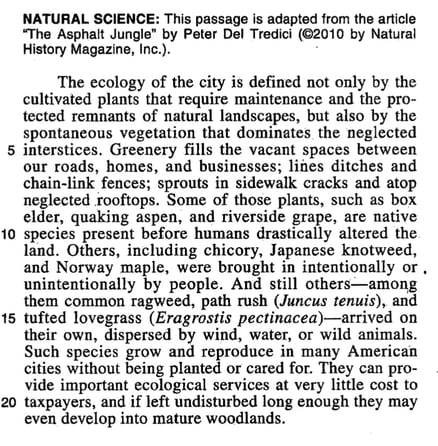The Key to Understanding SAT/ACT Passages? Read Like a 10-Year-Old. (Yes, really.)

Picture this: It’s 9:45 A.M. on a Saturday, and you’re sitting in an off-balance, tablet-arm desk chair in a high school thirty minutes from your house. You’re in one of five rows of such chairs, accompanied by thirty other students who are furiously scribbling graphite onto a bubble sheet. A fluorescent light hums overhead. You’re two hours into a three-hour ACT test, and every stimulus in the room is at once an annoyance and a tempting reprieve from the Reading section passage in front of you.
You do a double take—you’re on line 18, but you couldn’t recall a thing about the passage right now if your life depended on it. An exhausted sigh escapes your chest, and you return to the top of the page in hopes of retaining more on a second pass. To your dismay, the first sentence has six clauses and a pair of italicized species names. Rather than brave the wall of text, you decide to jump to the questions instead and take your chances.
It’s a scenario we’ve all found ourselves in. Compounded by the pressure of the ticking clock, the sheer volume of information on an SAT or ACT Reading passage can make even seasoned test takers feel overwhelmed. How can we hope to comprehend—much less analyze—a text as this pernicious mental fatigue sets in?
Any student I’ve tutored for the SAT or ACT knows that I propose a solution that’s as superficially silly as it is effective: As you read, explain the text to yourself as though you were talking to a ten-year-old.
What do I mean by this? An example will help illustrate the technique. Consider the following excerpt from a “Natural Science” passage on the ACT Reading section.

It takes only a moment’s glance at the opening sentence to understand why a student’s eyes might gloss over a passage like this.
The ecology of the city is defined not only by the cultivated plants that require maintenance and the protected remnants of natural landscapes, but also by the spontaneous vegetation that dominates the neglected interstices.
Rather than barrel through the rest of the paragraph and hope that the sentence’s meaning will magically clarify itself, pause for a moment and consider with me: what does that sentence mean? Let’s break it down phrase by phrase—and in simple, ordinary language that a 10-year-old could understand.
The ecology of the city [...]
Okay, pause. What does that phrase mean? You’d be astonished how often I see students casually read through deceptively simple phrases like this—phrases that are easy to pronounce, but whose meanings aren’t always understood. So, what is meant by “the ecology of the city”? Well, we know that ecology involves the relationships between living things and their surroundings. We might say that this phrase means something like: “The nature of the city.”
Alright, let’s continue.
[...] is defined not only by the cultivated plants that require maintenance [...]
Pause. “Cultivated plants that require maintenance”? What do we mean by that? To cultivate is to prepare for gardening, and maintenance is taking care of something. Put simply, this phrase says, “is not just the plants people take care of.”
Onward.
[...] and the protected remnants of natural landscapes [...]
Pause. Let’s translate this into fifth-grade language: “and the small patches of natural places that are protected.” By now, you’re probably getting the hang of this. Let’s bring it home with the final clause.
[...] but also by the spontaneous vegetation [...]
Wait a sec. Translate that for the 10-year-old crowd: “but also the wild plants"
[...] that dominates the neglected interstices [...]
"that take over the places people don’t pay attention to."
Now let’s compare:
The ecology of the city is defined not only by the cultivated plants that require maintenance and the protected remnants of natural landscapes, but also by the spontaneous vegetation that dominates the neglected interstices.
versus
The nature in the city is not just the plants people take care of and the small patches of natural places that are protected, but also the wild plants that take over the places people don't pay attention to.
See how much clearer that is?
Now, I know this technique seems tedious. Don’t worry, though—you won’t need to start and stop so frequently forever. With enough practice, the process will eventually become second nature. The reason this exercise feels like pulling teeth at the moment is that we’re training a muscle that you may have never consciously worked before in your whole academic career: the muscle of processing. By forcing yourself to translate a text into simple, straightforward language, you’re also forcing comprehension of it. Indeed, you can’t explain something simply if you don’t understand it.
Give this method a try the next time you come across a challenging SAT or ACT Reading passage. Not only will it enable you to understand the text to such an extent that you could explain it to your fifth-grade sibling, but chances are that it will jog you out of your second-hour-of-test-day mental fatigue, too.


